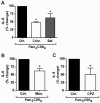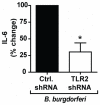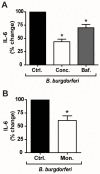Human integrin α(3)β(1) regulates TLR2 recognition of lipopeptides from endosomal compartments
- PMID: 20877569
- PMCID: PMC2943923
- DOI: 10.1371/journal.pone.0012871
Human integrin α(3)β(1) regulates TLR2 recognition of lipopeptides from endosomal compartments
Abstract
Background: Toll-like receptor (TLR)-2/TLR1 heterodimers recognize bacterial lipopeptides and initiate the production of inflammatory mediators. Adaptors and co-receptors that mediate this process, as well as the mechanisms by which these adaptors and co-receptors function, are still being discovered.
Methodology/principal findings: Using shRNA, blocking antibodies, and fluorescent microscopy, we show that U937 macrophage responses to the TLR2/1 ligand, Pam(3)CSK(4), are dependent upon an integrin, α(3)β(1). The mechanism for integrin α(3)β(1) involvement in TLR2/1 signaling is through its role in endocytosis of lipopeptides. Using inhibitors of endosomal acidification/maturation and physical tethering of the ligand, we show that the endocytosis of Pam(3)CSK(4) is necessary for the complete TLR2/1-mediated pro-inflammatory cytokine response. We also show that TLR2/1 signaling from the endosome results in the induction of different inflammatory mediators than TLR2/1 signaling from the plasma membrane.
Conclusion/significance: Here we identify integrin α(3)β(1) as a novel regulator for the recognition of bacterial lipopeptides. We demonstrate that induction of a specific subset of cytokines is dependent upon integrin α(3)β(1)-mediated endocytosis of the ligand. In addition, we address an ongoing controversy regarding endosomal recognition of bacterial lipopeptides by demonstrating that TLR2/1 signals from within endosomal compartments as well as the plasma membrane, and that downstream responses may differ depending upon receptor localization. We propose that the regulation of endosomal TLR2/1 signaling by integrin α(3)β(1) serves as a mechanism for modulating inflammatory responses.
Conflict of interest statement
Figures












Similar articles
-
TLR2 ligands induce NF-κB activation from endosomal compartments of human monocytes.PLoS One. 2013 Dec 12;8(12):e80743. doi: 10.1371/journal.pone.0080743. eCollection 2013. PLoS One. 2013. PMID: 24349012 Free PMC article.
-
Lipopeptides are signaled by Toll-like receptor 1, 2 and 6 in endolysosomes.Int Immunol. 2014 Oct;26(10):563-73. doi: 10.1093/intimm/dxu054. Epub 2014 May 24. Int Immunol. 2014. PMID: 24860120
-
Adaptor Protein-3-Mediated Trafficking of TLR2 Ligands Controls Specificity of Inflammatory Responses but Not Adaptor Complex Assembly.J Immunol. 2015 Nov 1;195(9):4331-40. doi: 10.4049/jimmunol.1501268. Epub 2015 Sep 30. J Immunol. 2015. PMID: 26423153 Free PMC article.
-
CD14 directly binds to triacylated lipopeptides and facilitates recognition of the lipopeptides by the receptor complex of Toll-like receptors 2 and 1 without binding to the complex.Cell Microbiol. 2006 Dec;8(12):1899-909. doi: 10.1111/j.1462-5822.2006.00756.x. Epub 2006 Jul 11. Cell Microbiol. 2006. PMID: 16848791
-
Phagosomal TLR signaling upon Borrelia burgdorferi infection.Front Cell Infect Microbiol. 2014 May 20;4:55. doi: 10.3389/fcimb.2014.00055. eCollection 2014. Front Cell Infect Microbiol. 2014. PMID: 24904837 Free PMC article. Review.
Cited by
-
Effects of over-expression of TLR2 in transgenic goats on pathogen clearance and role of up-regulation of lysozyme secretion and infiltration of inflammatory cells.BMC Vet Res. 2012 Oct 22;8:196. doi: 10.1186/1746-6148-8-196. BMC Vet Res. 2012. PMID: 23082910 Free PMC article.
-
Rapid Evaluation of Antibody Fragment Endocytosis for Antibody Fragment-Drug Conjugates.Biomolecules. 2020 Jun 25;10(6):955. doi: 10.3390/biom10060955. Biomolecules. 2020. PMID: 32630402 Free PMC article.
-
An alternative model for type I interferon induction downstream of human TLR2.J Biol Chem. 2020 Oct 16;295(42):14325-14342. doi: 10.1074/jbc.RA120.015283. Epub 2020 Aug 12. J Biol Chem. 2020. PMID: 32796029 Free PMC article.
-
TRIF mediates Toll-like receptor 2-dependent inflammatory responses to Borrelia burgdorferi.Infect Immun. 2013 Feb;81(2):402-10. doi: 10.1128/IAI.00890-12. Epub 2012 Nov 19. Infect Immun. 2013. PMID: 23166161 Free PMC article.
-
TLR2 ligands induce NF-κB activation from endosomal compartments of human monocytes.PLoS One. 2013 Dec 12;8(12):e80743. doi: 10.1371/journal.pone.0080743. eCollection 2013. PLoS One. 2013. PMID: 24349012 Free PMC article.
References
-
- Takeuchi O, Akira S. Pattern recognition receptors and inflammation. Cell. 2010;140:805–820. - PubMed
-
- Ferwerda G, Meyer-Wentrup F, Kullberg BJ, Netea MG, Adema GJ. Dectin-1 synergizes with TLR2 and TLR4 for cytokine production in human primary monocytes and macrophages. Cell Microbiol. 2008;10:2058–2066. - PubMed
-
- Schwandner R, Dziarski R, Wesche H, Rothe M, Kirschning CJ. Peptidoglycan- and lipoteichoic acid-induced cell activation is mediated by toll-like receptor 2. J Biol Chem. 1999;274:17406–17409. - PubMed
-
- Yoshimura A, Lien E, Ingalls RR, Tuomanen E, Dziarski R, et al. Cutting edge: recognition of Gram-positive bacterial cell wall components by the innate immune system occurs via Toll-like receptor 2. J Immunol. 1999;163:1–5. - PubMed
Publication types
MeSH terms
Substances
Grants and funding
LinkOut - more resources
Full Text Sources
Medical
Miscellaneous

